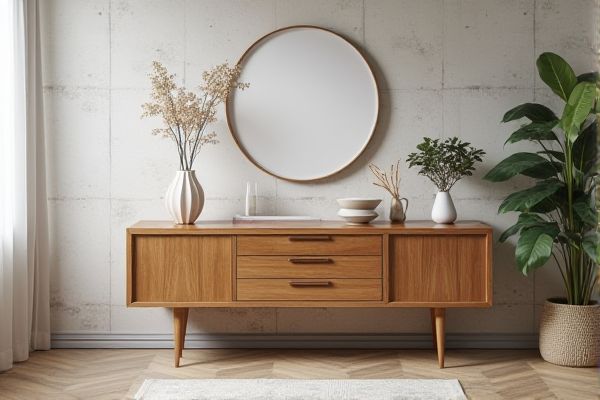
Console tables typically feature a narrow design ideal for hallways or entryways, providing a minimalist surface for decor or essentials, while sideboards offer extensive storage space with cabinets and drawers, making them perfect for dining rooms to store dishes and linens. Explore the full article to understand which piece best suits Your space and functionality needs.
Table of Comparison
| Feature | Console Table | Sideboard |
|---|---|---|
| Primary Use | Decorative surface, entryway, or hallway storage | Dining room storage for dishes, utensils, and linens |
| Design | Long, narrow, minimal storage or open shelves | Broader, bulkier with cabinets and drawers |
| Storage Capacity | Limited; best for small items or decor | Ample; designed for organized dining storage |
| Placement | Hallways, entryways, behind sofas | Dining rooms or living rooms |
| Height | Typically 28-32 inches | Typically 30-36 inches |
| Material | Wood, metal, glass; often sleek design | Wood or wood veneer; more solid and traditional |
Understanding Console Tables and Sideboards
Console tables, typically narrow and long, are designed to fit against walls in entryways or hallways, providing a surface for decor or keys without occupying much space. Sideboards, often larger and more robust, serve as storage furniture in dining rooms, featuring cabinets and drawers to store dishes, linens, and serving utensils. Understanding these functional distinctions helps in choosing the right piece for your space, balancing aesthetics with practical storage needs.
Key Differences Between Console Tables and Sideboards
Console tables are typically narrower and taller, designed for entryways or behind sofas, providing a surface for decor or small storage without occupying much space. Sideboards offer more substantial storage with cabinets and drawers, making them ideal for dining rooms to store dishes, linens, and serving ware. Understanding these distinctions helps you choose the right furniture to balance style and functionality in your living or dining areas.
Design and Style Comparison
Console tables feature a slim, minimalist design ideal for narrow spaces and often showcase open or sleek metal frames that enhance modern or contemporary decor. Sideboards typically offer bulkier, enclosed storage with doors and drawers, incorporating classic, rustic, or traditional styles suited for dining rooms to store tableware. Your choice depends on whether you prioritize versatile surface display with a lightweight aesthetic or substantial storage paired with a statement furniture piece.
Functional Uses of Console Tables
Console tables provide versatile functional uses by serving as narrow surfaces perfect for entryway organization, such as holding keys, mail, or decorative items. Their slim design allows placement in tight spaces, making them ideal for added storage without overwhelming your room layout. Unlike sideboards, console tables often emphasize both practicality and aesthetic appeal in hallways or behind sofas.
Functional Uses of Sideboards
Sideboards primarily serve as versatile storage units in dining and living rooms, offering ample space for organizing dinnerware, linens, and serving utensils. You can also use sideboards as display surfaces for decorative items, enhancing the room's aesthetic while maintaining functionality. Their combination of drawers and cabinets makes them ideal for both concealed storage and easy access during meals or gatherings.
Storage Capabilities: Console Table vs Sideboard
Sideboards offer significantly more storage capabilities than console tables, featuring multiple drawers and cabinets designed for organizing dinnerware, linens, and larger household items. Console tables typically provide minimal storage, often limited to a single shelf or small drawer, making them ideal for decorative purposes or holding smaller accessories. For maximizing storage in dining or living areas, sideboards are the preferred choice due to their versatile compartments and spacious design.
Ideal Placement in Home Decor
Console tables are ideal for narrow spaces like entryways or hallways, providing a sleek surface for keys and decorative items without overwhelming the area. Sideboards fit well in dining rooms or living rooms, offering substantial storage and serving space for dishes, linens, or barware. Choosing the right piece depends on your spatial needs and the functional role you want to enhance in your home decor.
Material and Construction Variations
Console tables often feature lightweight materials such as metal frames with glass or wood tops, emphasizing sleek and minimal construction ideal for narrow spaces. Sideboards typically showcase robust hardwoods like oak, walnut, or maple combined with solid panel construction, designed for durability and ample storage. The material choices and construction techniques reflect their functional roles: console tables prioritize style and accessibility, while sideboards focus on strength and organization.
Choosing the Right Option for Your Space
Console tables offer a sleek, narrow design ideal for small entryways or hallways, providing surface space without overwhelming the area. Sideboards deliver ample storage and a larger countertop, perfect for dining rooms or living spaces needing both display and organization. Consider room size, storage needs, and functional use when selecting between a console table and sideboard to maximize space efficiency and style.
Maintenance and Care Tips
Console tables require regular dusting with a soft cloth to prevent surface scratches and occasional polishing to maintain their finish. Sideboards, often featuring cabinets and drawers, need careful cleaning of hardware and interior shelves to avoid dust buildup and ensure smooth functionality. You can extend the lifespan of both furniture types by avoiding exposure to direct sunlight and using coasters or placemats to prevent stains and heat damage.
 homyna.com
homyna.com